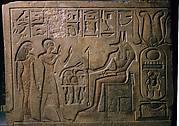Anubis

Anubis is one of the most well known and iconic gods of ancient Egypt. Anubis is actually the Greek version of his name. Inpu or Anpu is what the ancient Egyptians would have called him. He was the god of the dead and the god of embalming. The Egyptians saw that there were often jackals hanging around the graveyards, so they took that as a sign that Anubis was the jackal watching over the dead. After Osiris was murdered by Seth, Anubis was the god who helped embalm him. He was also the part of the mummification process and priests often wore masks that looked like the head of Anubis during that process. Anubis is extremely old for he has been found in the oldest mastabas of the Old Kingdom and the pyramid texts. Originally he was the god of the underworld but later became particularly associated with the embalming and funerary process.
His Egyptian name comes from the root word for a royal child, “inpu”. In the Early Dynastic period and the Old Kingdom, he enjoyed a preeminent (though not exclusive) position as lord of the dead, but he was later overshadowed by Osiris (Encyclopedia Britannica online/ Anubis). His role is reflected in such epithets as “He Who Is upon His Mountain” (i.e., the necropolis), “Lord of the Sacred Land,” “Foremost of the Westerners,” and “He Who Is in the Place of Embalming” (Anubis| Egyptian God, Encyclopedia Britannica ). He was actually known as the inventor of embalming. In the book of the dead we find that in the representations of the judgement of the dead, besides Osiris we have Anubis, both responsible for the weighing of the soul (Lockyer 28).
In the image of the carved stele, Saimun and Taruy are worshipping Anubis. The image is carved into sandstone and was painted although most of the pigment from the paint has worn away. It is an ancient artifact dating back to around 1550 – 1295 B.C. Above the figures on the stele are hieroglyphics that express the event depicted below. It comes from the 18th dynasty during the reign of Thutmose IV and the New Kingdom period. The figure closest to Anubis has his hands up to depict that he is worshipping Anubis. Also, in between Anubis and the closest figure is an accumulation of items possibly brought as an offering to Anubis. In conclusion, Anubis is an important and iconic figure in Egyptian history and there are still certain groups of people in Egypt that worship him, so obviously this god is not going away anytime soon.
By Josh Ford
Citations
Lockyer, Norman. The Dawn of astronomy: a study of the temple worship and mythology of the ancient Egyptians. Macmillan and Company, 1893.
“Anubis | Egyptian God.” Encyclopedia Britannica Online. Accessed March 12, 2015. http://www.britannica.com/EBchecked/topic/29015/Anubis.
Image Citation : http://www.metmuseum.org/collection/the-collection-online/search/554784?rpp=30&pg=1&ft=anubis&pos=17
